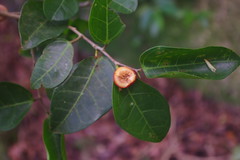Listen to the sounds of an empty forest...
 |
| Karst forest |
Dispersal modes and vertebrate dispersers. Roughly 85% of forest tree species in Mariana Island forests have fleshy fruits adapted for vertebrate dispersal which is similar to the proportion in tropical forests around the world. No native forest tree species found in the Mariana Island forests are known to be wind dispersed, and secondary dispersal is unlikely
 to play a large role in
this system because there are no scatter-hoarding rodents, large ants,
or other seed-eating invertebrates on the islands. Non-native ungulates (pigs and deer)
present on two of the four islands have been shown to disperse a limited
set of the forest trees. The primary seed dispersers in the Marianas
are birds and bats. There are six native frugivorous forest bird species
in the Marianas (White-throated Ground Dove, Mariana Fruit Dove,
Bridled White-eye,Golden White-eye, Mariana Crow, Micronesian Starling)
and one frugivorous bat species (Mariana Fruit Bat). Guam, however, has
functionally no native vertebrate frugivores left due to the
introduction of the brown treesnake (Boiga irregularis) in the mid
1940’s. There is one small, localized population
of one frugivorous bird species (Micronesian Starling) and one non-native frugivorous bird species (Island Collared Dove) that
coexist with the snake in urban and grassland areas, but are rarely present
in forested areas.
to play a large role in
this system because there are no scatter-hoarding rodents, large ants,
or other seed-eating invertebrates on the islands. Non-native ungulates (pigs and deer)
present on two of the four islands have been shown to disperse a limited
set of the forest trees. The primary seed dispersers in the Marianas
are birds and bats. There are six native frugivorous forest bird species
in the Marianas (White-throated Ground Dove, Mariana Fruit Dove,
Bridled White-eye,Golden White-eye, Mariana Crow, Micronesian Starling)
and one frugivorous bat species (Mariana Fruit Bat). Guam, however, has
functionally no native vertebrate frugivores left due to the
introduction of the brown treesnake (Boiga irregularis) in the mid
1940’s. There is one small, localized population
of one frugivorous bird species (Micronesian Starling) and one non-native frugivorous bird species (Island Collared Dove) that
coexist with the snake in urban and grassland areas, but are rarely present
in forested areas.In contrast, the nearby islands of Saipan, Tinian and Rota have relatively intact frugivore communities. Hunting, along with the snake (on Guam), led to the near complete extirpation of fruit bats from all four islands; there are no bats on Tinian, <10 bats left on Guam, <25 on Saipan, and about 2000 on Rota.
Seasonality in the Marianas. The Mariana islands experience a dry season from January to June and a wet season between July and December, when tropical storms and typhoons are most likely to occur. The majority of tree species fruit annually for a continuous period between April and August, with significant variation between individuals in the onset and cessation of fruiting. Some species fruit bi-annually, while others fruit continuously throughout the year. The lowest period of fruiting is in the end of the wet season (October-December).
Photos courtesy Isaac Chellman and Evgenia Dubman.

